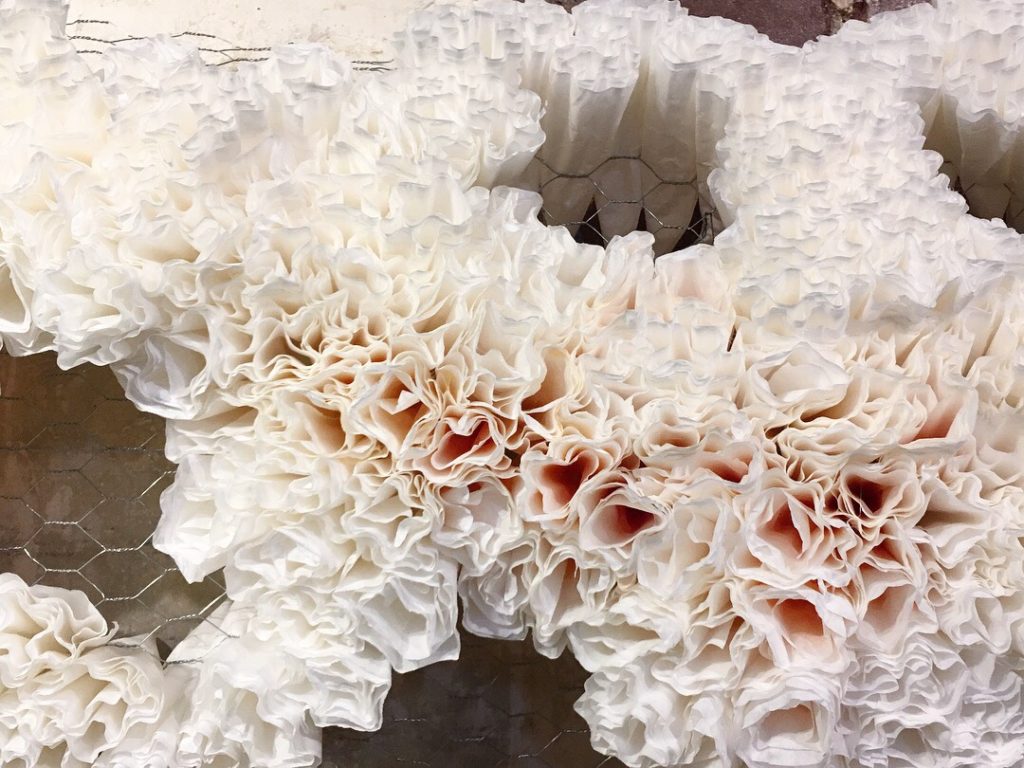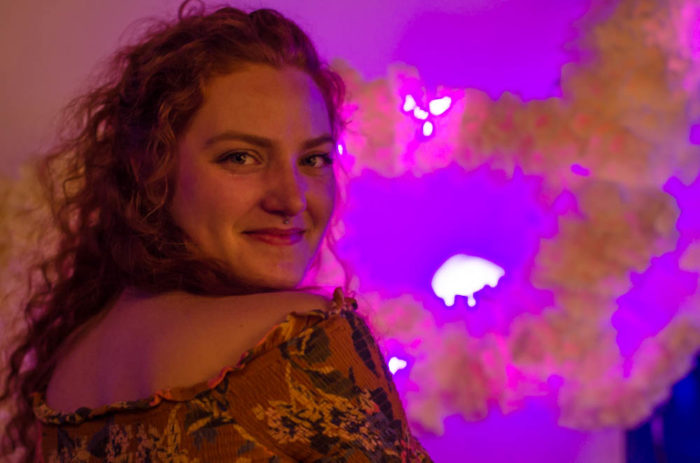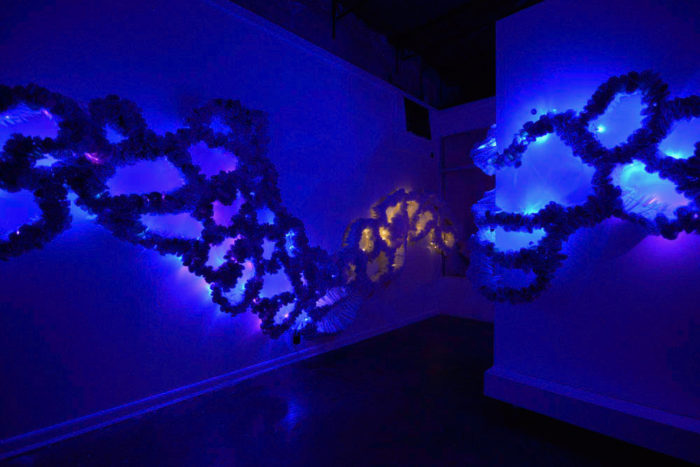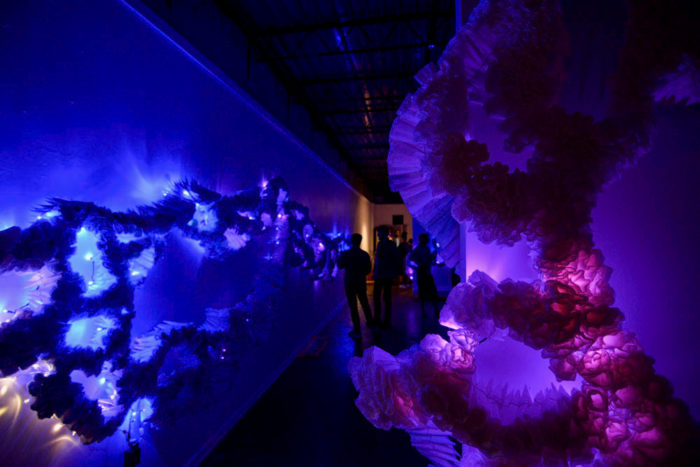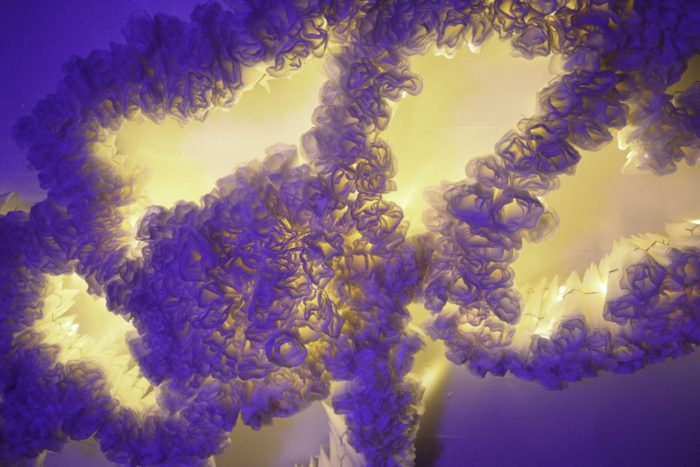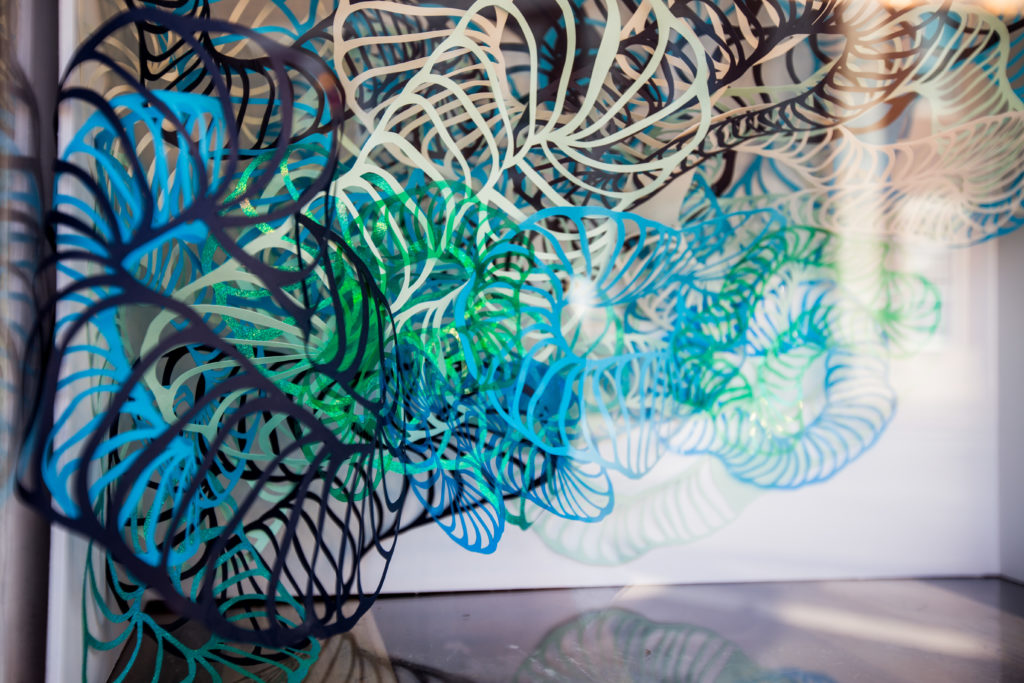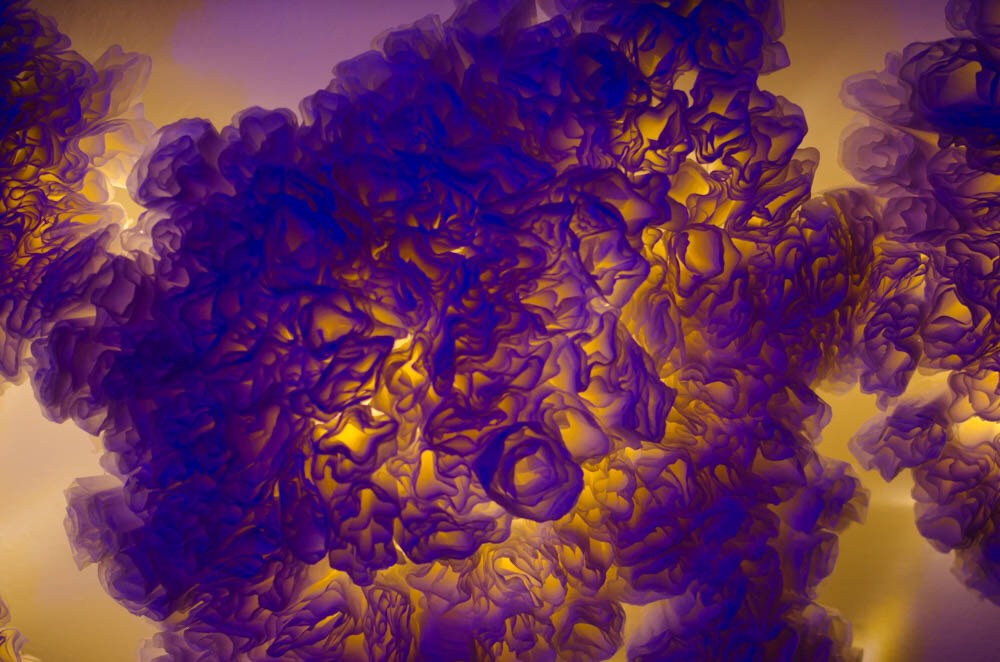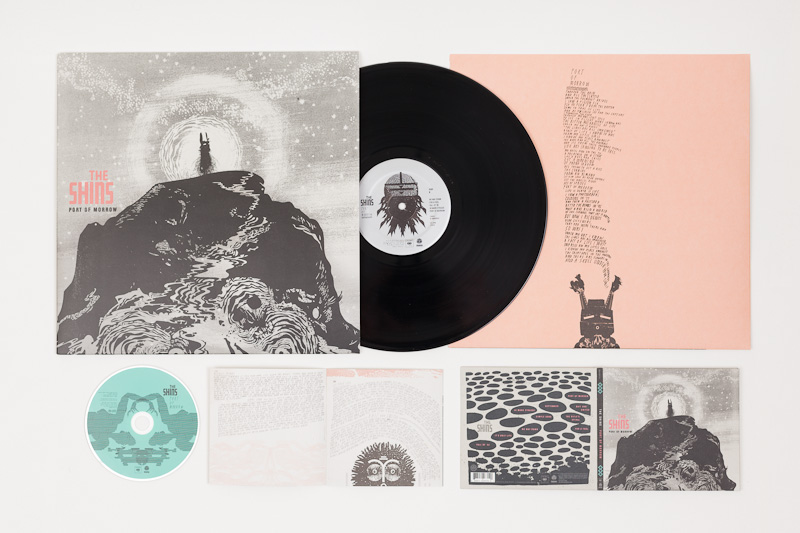Movement and life: When experiencing Elise Williams’ coffee-filter coral reef installation 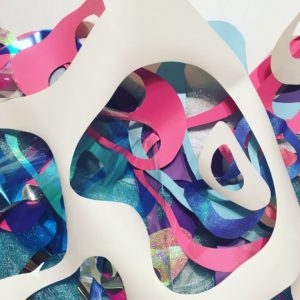 glowing with light, or her paper blooms that practically burst off of the walls, you can’t help but stop and witness. Her work is still yet dynamic, grand yet detailed.
glowing with light, or her paper blooms that practically burst off of the walls, you can’t help but stop and witness. Her work is still yet dynamic, grand yet detailed.
Growing up in Augusta, Georgia, with two doctors for parents, Elise Williams originally gravitated to the medical field. She looked toward biology or chemistry but found that when it was time to decide, she instead chose to major in art. Other than a few drawings and paintings she had created in high school, graduating with a Studio Art degree from Georgia College & State University ended up being the best leap of faith the artist ever took.
Williams’ fascination with science naturally led her to be inspired by the microscopic world — she says she loves thinking about the similarities and differences of the microscopic and macroscopic worlds.
Her works capture the lushness of living forms by employing a diverse range of colors and textures. Here, Williams talks with CommonCreativ about finding her way to her favorite medium, her go-to tools, and how she personally defines “art.”
CommonCreativ: What got you into art?
Elise Williams: I only really started getting into art when I went to college. I had some amazing professors that changed the way I saw art and opened me up to what art can be. I definitely would not be where I am now without them and their advice over the years.
CC: What informed your current style?
EW: I love working with paper. I studied printmaking in school and worked two-dimensionally for pretty much my whole time in school. I became extremely interested in how I could turn my two-dimensional works into something more sculptural. It wasn’t until my capstone project that I decided to give it a try. Through a lot of trial and error of different materials, I landed on coffee filters. This medium has been a game changer for me. It’s so versatile.
I’ve discovered different ways of dyeing to add pops of color into my pieces. I have a specific “rolling” technique that I use to create a cone shape with the coffee filters that allows me to fill a structure of chicken wire with them. The texture created when the coffee filters are massed together is quite beautiful.
CC: What are your favorite tools and mediums?
EW: For cut paper pieces I use an X-Acto knife. I love that tool. It’s fun to approach a piece of paper with an X-Acto knife but just treat it as if I’m drawing. For my installations, I have a couple of go-to tools to get the job done: a power drill, hot glue gun, wire cutters, and needle nose pliers.
CC: When do you know a piece you’ve created is complete?
EW: I really feel that most of the pieces could forever be worked on or added to. Usually, I can tell that a piece is done or nearly done when I’m OK showing it to people. If I don’t want anyone to see it, I know it still needs work.
CC: How would you define art?
EW: There’s this Tom Robbins quote [from his novel Skinny Legs and All] that I enjoy: “If there’s a thing, a scene, maybe, an image that you want to see real bad, that you need to see but it doesn’t exist in the world around you, at least not in the form that you envision, then you create it so that you can look at it and have it around, or show it to other people who wouldn’t have imagined it because they perceive reality in a more narrow, predictable way. And that’s it. That’s all an artist does.”
For me, art is all about having fun and making things I want to see. Defining good art seems nearly impossible. People view things so different from one another. It’s hard to confine art to what is good or bad. Art can also be so many different things. I really enjoy art that evokes a feeling in the viewer. That is something I hope to achieve with my own pieces.
CC: What’s one of your favorite pieces?
EW: One is a piece I had on view at [coffeehouse and venue] Kavarna in Decatur last November. It’s the only time I have left exposed chicken wire to be seen. I think the organic texture of the coffee filters mixed with the geometric shape of the chicken wire is a really nice pairing.
My absolute favorite piece is the installation [called DIVE] I just made for my artist residency at Murmur. I had the opportunity to try so many new things. It was all a big experiment but turned out almost exactly as I hoped it would. I was able to work on a much larger scale and incorporate sound and lighting to create a fully immersive experience.
CC: Tell me more about DIVE.
EW: I was approached by Tash at Murmur and asked if I would be interested in being their artist-in-residence starting in January. Honestly, at first, I was a bit hesitant. I had never done an extended residency before and wasn’t sure I would be able to pull it off. The more I thought about it, I knew that I could not let this opportunity pass. It was the perfect time and place to try to accomplish something larger than I had ever done before. Going into this residency I knew I wanted to do an installation with materials I had worked with before: coffee filters. The rest was going to be completely an experiment. The only plan I had was to create an installation that simulated diving into water. I wanted to take this installation to the next level by creating a fully immersive deepwater experience for the viewer. To accomplish this I incorporated experimental lighting and a unique soundscape.
DIVE was created for day and night viewing as if it was actually alive. Daytime and nighttime viewing are drastically different from one another. Daytime is bright and shows all of the various colors of the coffee filters — the colors themselves were chosen to mimic a dive into water. Starting with white in the front to represent the surface and bubbles, like if you just jumped in or dove into the ocean. As you walk deeper into the space, you encounter many shades of blue and purple to give a feeling of being deeper underwater. Finally, at the end, it blends back to white — a re-emergence. Nighttime viewing has the lights off in Murmur and the installation is self-illuminated. I have a light fader that dims and brightens the lights throughout the installation to give it a glowing, breathing effect. Nighttime viewing is pretty magical.
CC: What was the creation process?
EW: The process of creating DIVE is pretty simple at its core. I start with accumulating materials, dyeing the coffee filters, cutting, folding, and gluing them, then I installed the chicken wire in the space. This is the shell that I build off of — it’s like I’m creating a three-dimensional sketch which can be reworked until I’m happy with the composition and movement. Then I glue in the coffee filters and place certain colors in certain locations intuitively. It’s always interesting to see the final product, I’m completely going off of whatever I see in my head. Every time the installation turns out very different. I love the process of the unknown. It’s definitely a love-hate relationship, but I always end up learning a lot about my process and ways to improve for future projects.
CC: What’s it like to be an artist-in-residence at Murmur?
EW: It has been an amazing experience. Tash and Brandon have always been so supportive and helpful to me through this residency. They completely put their trust in me to use the space however I wanted, which in turn allowed me to do something completely different and experimental that I couldn’t have accomplished anywhere else.
CC: What do you currently have in the works?
EW: I’m [working on] a solo show at the Decatur Arts Alliance Gallery for this summer. I plan to do something a little different for that one.
CC: What’s one thing you love about Atlanta?
EW: There is so much diversity in Atlanta, I love that. There are so many different communities and neighborhoods. I love being able to still learn about new places and things within Atlanta. Moving here from Milledgeville has been so amazing and refreshing.
CC: What do you think about the local arts scene?
EW: I feel like I learn about a new gallery or art space every day — there are so many! The art scene seems full of opportunities if you apply yourself and put yourself out there. It has taken a long time and lots of work to even get to this point I am at now, and I know I’ve only touched the surface.
CC: Dreams for yourself?
EW: I hope to never stop creating and being inspired by what is around me. As long as I am doing that, I know I will be fulfilled and happy!
CC: Dreams for the world?
EW: Respect, equality, and empathy are a few things I wish to see more of in the world.
CC: Lastly, any advice for emerging artists?
EW: Persistence is key! At least that’s how it has been for me. Apply to everything you can and don’t be afraid to just send out an email to a gallery or coffee shop or anywhere! Understand that you won’t get into every show you apply for and don’t let that discourage you. As long as you keep trying you will continue to grow and learn, and good things will come from that.
See more of Elise’s work on her portfolio site and Instagram.

